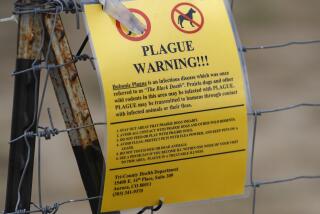Geneticists decode Black Death genome
- Share via
Europe’s feared Black Death wiped out about 30 million people -- 30 to 50% of the population on the continent -- in a period of just five years, between 1347 and 1351.
Now geneticists have reconstructed the genome of the bug that caused the plague -- an ancient strain of a bacterium called Yersinia pestis -- and have discovered that it wasn’t so different from descendants existing today.
The discovery, made by scientists at McMaster University in Canada, the University of Tubingen in Germany and collaborators at other institutions, was described in a study published Wednesday in the journal Nature.
The group collected the ancient Y. pestis DNA from 46 teeth and 53 bones excavated from the East Smithfield burial ground in London, a site set aside for burial of plague victims in late 1348 or early 1349. Researchers carefully reconstructed the bacterium’s genome and made comparisons to the genomes of existing strains of Y. pestis.
They determined that the bug hadn’t changed much in the more than 600 years since the plague swept Europe. Because estimates have indicated that all existing strains of Y. pestis evolved from a common ancestor sometime between 668 and 729 years ago -- not long before the East Smithfield strain killed its victims -- the team concluded that “the medieval plague of the fourteenth century was probably responsible for its introduction and widespread distribution in human populations.”
According to a statement issued by McMaster University, the study marks the first time scientists have published the genome of an ancient pathogen. Having the ability to study the genetic makeup of long-gone pathogens will help researchers track their evolution, said study coauthor Johannes Krause of the University of Tubingen. It could improve scientists’ understanding of modern diseases as well.
Bubonic plague still strikes somewhere between 1,000 and 3,000 people each year, according to the World Health Organization. The U.S. Centers for Disease Control report that on average, 10 to 15 Americans get the disease each year, mainly in rural areas. In May, Booster Shots reported on one such person, a 58-year-old man who caught the disease this year in New Mexico.
He reportedly recovered. Bubonic plague responds to antibiotics if discovered and treated quickly.
Click here to learn more about plague from the CDC.






